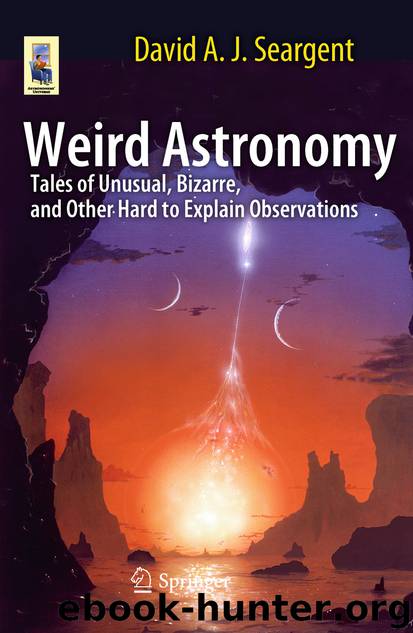Weird Astronomy by David A.J. Seargent

Author:David A.J. Seargent
Language: eng
Format: epub
Publisher: Springer New York, New York, NY
Black Meteors
Have you ever been watching the sky for meteors – probably during the time of a meteor shower – when you suddenly seem to see a dark object shoot across the sky for a short distance. What you see looks just like a small meteor, in all but one important respect. It is not luminous!
“Black meteor” reports are certainly not confined to novice meteor watchers. They are experienced by old hands at the art as well. The trouble is, according to all accepted wisdom, they simply cannot exist!
Any macroscopic physical object traveling at meteor speed through the atmosphere necessarily must become incandescent due to friction. There is simply no way around this. So if they don’t exist, why are they so often reported?
The usual explanation is that these events are optical illusions. In support of this, it is noted that many of the sightings occur either just after a meteor watch begins or shortly before one ends. In the first instance, it is asserted, the human eye has not properly settled down to dark adaptation, and misperceptions are more likely to happen.
Conversely, toward the end of the watch (especially if it has been a long one), fatigue is prone to start setting in. Under these circumstances, one is more likely to “see” something that isn’t really there.
On the other hand, sometimes a black meteor might indeed be a real object. The trouble is, it will not be a meteor!
If one is observing from a site that is free from low-level glare while at the same time having a mildly light polluted sky – a rural area close to a large town, for instance – a flying insect silhouetted against the background sky might be mistaken for a dark meteor. In this instance, however, the “track” is likely to be quite long.
If there is also a degree of local glare, as is common on a lighted suburban street, a flying insect has less chance of being seen in silhouette against the sky. Under these conditions, it is more likely to be illuminated from beneath by the local streetlights. Rather than being mistaken for a black meteor, it is then far more likely to be mistaken for an ordinary luminous meteor, as is evidenced by the earlier instance of a night bird being mistaken for an erratic Perseid!
Project 15Black and Erratic Meteors
Here is an interesting project for somebody with meteor-watching friends in both suburbia and the country. Simply have them record each instance of apparent black or curved meteors and compare the two sets of results. If bugs and birds are really responsible for these reports, the rural observers should report more black and fewer curved “meteors” than their suburban counterparts.
Does this happen? Only one way to find out!
Download
This site does not store any files on its server. We only index and link to content provided by other sites. Please contact the content providers to delete copyright contents if any and email us, we'll remove relevant links or contents immediately.
| Aeronautics & Astronautics | Astronomy |
| Astrophysics & Space Science | Comets, Meteors & Asteroids |
| Cosmology | Mars |
| Solar System | Star-Gazing |
| Telescopes | UFOs |
Tools of Titans by Timothy Ferriss(8304)
Turbulence by E. J. Noyes(7977)
Secrets of Antigravity Propulsion: Tesla, UFOs, and Classified Aerospace Technology by Ph.D. Paul A. Laviolette(5332)
Astrophysics for People in a Hurry by Neil DeGrasse Tyson(5151)
Room 212 by Kate Stewart(5070)
Design of Trajectory Optimization Approach for Space Maneuver Vehicle Skip Entry Problems by Runqi Chai & Al Savvaris & Antonios Tsourdos & Senchun Chai(5037)
Pale Blue Dot by Carl Sagan(4953)
The David Icke Guide to the Global Conspiracy (and how to end it) by David Icke(4655)
A Journey Through Divination and Astronomy by Publishing Pottermore(4363)
Goodbye Paradise(3761)
Apollo 8 by Jeffrey Kluger(3667)
COSMOS by Carl Sagan(3588)
The Five People You Meet in Heaven by Mitch Albom(3520)
Losing the Nobel Prize by Brian Keating(3518)
How to Read Water: Clues and Patterns from Puddles to the Sea (Natural Navigation) by Tristan Gooley(3431)
Brief Answers to the Big Questions by Stephen Hawking(3392)
How to Read Nature by Tristan Gooley(3290)
The Order of Time by Carlo Rovelli(3162)
A Brief History of Time by Stephen Hawking(2991)
